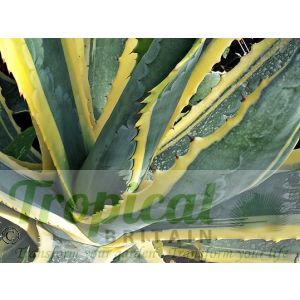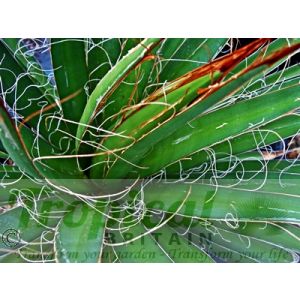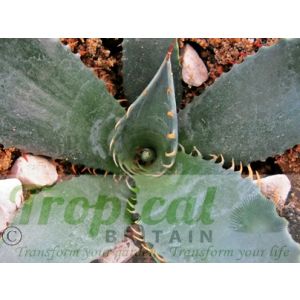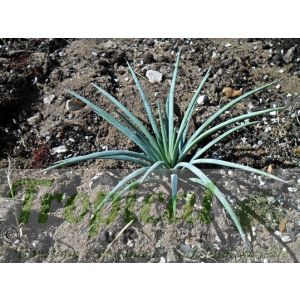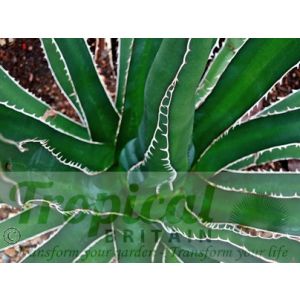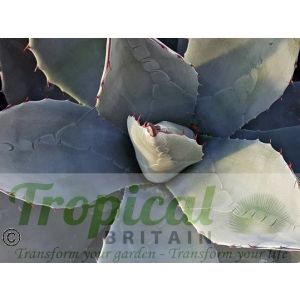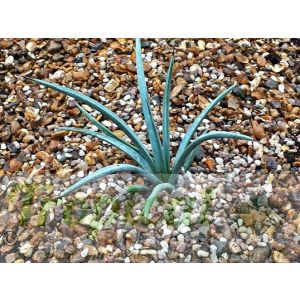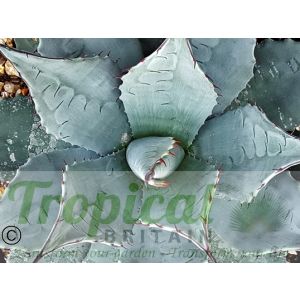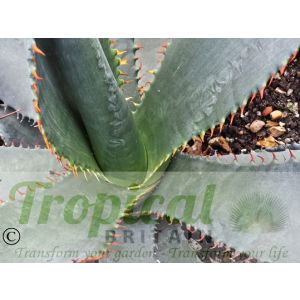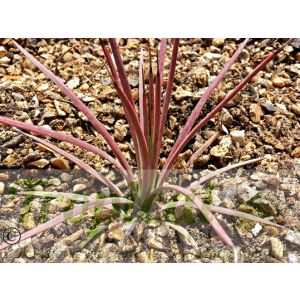- Compact architectural form
- Pale blueish-green foliage
- Hardy to at least -15C with good drainage
- Full sun
Agave parryi var. couesii (Coues Agave) is a very attractive variety of Agave parryi with a compact yet open symmetrical form and smaller narrower leaves that are noticeably more green than the usually darker steel-grey-blueish colour of the type species. This colouration matures into a pale bluish-green. The rosette is also more open than Agave parryi. These are the main obvious differences that the grower and collector notices but there are also taxonomic differences in the flower which is smaller in this variety with the tepal tips more densely covered in minute hairs than Agave parryi.
Agave parryi var. couesii grows in Central Arizona in Gila and Yavapai Counties on the highland slopes of the Aqua Fria and Verde River watersheds at the most north-westerly part of the distribution of Agave parryi in dispersed chapparal, oak woodlands amd mixed pine and juniper scrub on gravelly gradients at elevations of 1100-2100 metres above sea level. Like Agave parryi it is a very tough and cold-tolerant Agave and given good drainage Agave parryi var. couesii is capable of surviving down to at least -15C and probably more. We find it suckers freely and the offsets can start appearing when the plants are as young as two years old.
It tolerates the typically wet conditions of a British summer and under such conditions has a moderate growth rate, neither stunningly fast nor painfully slow.
A highly recommended Agave - not often available - which because of its extreme frost hardiness and attractive sculptural form is suitable both for the beginner and for the connoisseur.
Additional Information
| Order | Asparagales |
|---|---|
| Family | Asparagaceae |
| Sub-Family | Agavoideae |
| Synonyms | Agave couesii |
| Geographical Origin | USA: Central Arizona, in Gila and Yavapai Counties |
| Cultivation | Full sun. Perfect drainage in a porous gravelly/sandy/rocky soil. Moderate water in summer |
| Eventual Height | 60cm |
| Eventual Spread | 60cm |
| Hardiness | With good drainage Agave parryi var. couesii is hardy down to at least -15C |
1 Item
-
Suckers freely indeedFunny you mention that it suckers freely in the write up.
Upon planting up I found mine to have a little sucker too, so planted at a slant to allow more light to it and it's developing quickly.
Review by Ferdinand
Posted on
1 Item

Free DELIVERY
ON ALL ORDERS OVER £99THIS OFFER IS VALID ON ALL OUR STORE ITEMS.


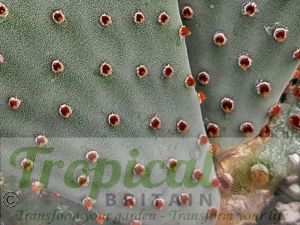

THE PLANTS
- Smaller-Growing Succulents
- Aeonium
- Agave
- Agave americana
- Agave amica
- Agave chrysantha
- Agave cupreata
- Agave deserti
- Agave filifera
- Agave gentryi
- Agave gomezpompae
- Agave havardiana
- Agave horrida ssp horrida
- Agave lechuguilla
- Agave mitis var mitis
- Agave montana
- Agave palmeri
- Agave parryi
- Agave polianthiflora
- Agave striata
- Agave stricta Rubra
- Agave toumeyana
- Agave univittata
- Agave utahensis
- Agave victoriae-reginae - Huasteca Canyon
- Aloe
- Beschorneria
- Bryophyllum
- Dasylirion
- Furcraea
- Hesperaloe
- Hesperoyucca
- Nolina
- Yucca
- Astrophytum
- Austrocylindropuntia
- Brasiliopuntia brasiliensis
- Cereus
- Chamaecereus silvestrii
- Cleistocactus
- Cumulopuntia
- Cylindropuntia
- Echinocereus
- Echinopsis
- Epiphyllum
- Ferocactus
- Gymnocalycium
- Hatiora
- Kroenleinia grusonii
- Lophocereus
- Maihuenia
- Mammillaria
- Matucana
- Myrtillocactus geometrizans
- Opuntia
- Opuntia arenaria SB964
- Opuntia atrispina
- Opuntia basilaris
- Opuntia chisosensis SB992 Brewster Co, TX
- Opuntia cymochila - Brewster Co, TX
- Opuntia engelmannii var. sandia
- Opuntia erinacea
- Opuntia fragilis
- Opuntia humifusa
- Opuntia lindheimeri - Beeville, TX
- Opuntia phaeacantha
- Opuntia pottsii var. nova DJF1441 SW Albuquerque, NM
- Opuntia robusta
- Opuntia sandiana
- Opuntia sanguinicola
- Opuntia stricta
- Opuntia strigil
- Opuntia trichophora
- Oroya peruviana
- Parodia
- Polaskia
- Rhipsalis
- Schlumbergera
- Stenocactus
- Stetsonia
- Tephrocactus
- Alocasia
- Amorphophallus
- Arisaema
- Arum
- Calla
- Caladium
- Colocasia
- Dracunculus
- Monstera
- Helicodiceros muscivorus
- Philodendron
- Pinellia
- Remusatia
- Sauromatum
- Spathantheum
- Typhonium
- Xanthosoma
- Zantedeschia
